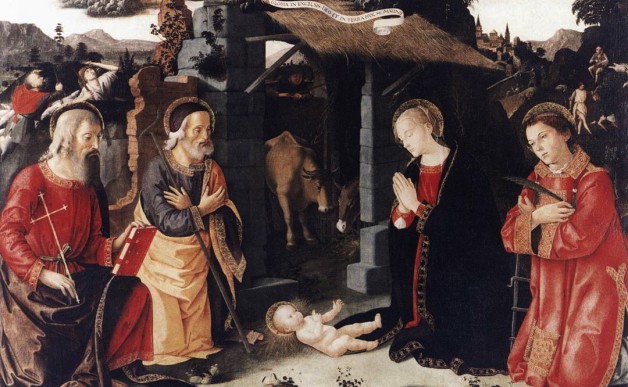Christmas is over. It’s time to get prepared for the next national Holy Day of Consumer Obligation: Valentine’s Day. This, at least, is the message I get from the world when I’ve just begun to celebrate the Octave of Christmas. In a way, however, the Church is also asking us to move beyond Christmas. How so? By placing the feasts of martyrs on these first days following the Nativity. The Incarnation, after all, is not for fun and presents, but for a decisive purpose: to save us from our sins by means of Christ’s death on the Cross. Discussing whether Christ would have become Incarnate if sin had not entered the world, St. Thomas says,
Since everywhere in the Sacred Scripture the sin of the first man is assigned as the reason of the Incarnation, it is more in accordance with this to say that the work of the Incarnation was ordained by God as a remedy for sin; so that, had sin not existed, the Incarnation would not have been. (ST, III, 1, 3)
These first few days following Christmas remind us that the Passion and Cross, although distant chronologically, are yet on the logical horizon. The Cradle and the Cross are not to be separated.
And yet, between the celebration of St. Stephen and Holy Innocents we find the feast of St. John the Evangelist, the only Apostle who was not martyred. (In fact, St. Thomas thinks he was assumed into heaven bodily after falling asleep!) What are we to make of this incongruity? Is it a liturgical oversight from the Middle Ages? Or is it a sort of “Gaudete” or “Laetare” feast day, designed to interrupt the succession of martyrs’ days? Should rose-colored vestments be allowed a third appearance during the year?
Two questions seem important here: Why was St. John spared a martyr’s death? And why is he sandwiched between martyrs this week? Perhaps the two are related and mutually illuminating.
The Catechism says,
Martyrdom is the supreme witness given to the truth of the faith: it means bearing witness even unto death. The martyr bears witness to Christ who died and rose, to whom he is united by charity. (CCC, 2473)
While it is true that St. John was not slain for the faith, he certainly did bear “witness to Christ who died and rose,” and he certainly did so as one “united [to him] by charity.”
First, St. John was the only one of the Twelve that remained with Christ under the Cross. While the other disciples hid, St. John stayed with Christ and was given the responsibility of looking after Mary. We are used to thinking of Mary’s suffering under the Cross, and so we call her the Mater Dolorosa, the “Mother of Sorrows”; but John has a claim to a similar title.
Second, St. John was “the beloved disciple,” the one whom Jesus loved, the one allowed to recline next to Jesus at the Last Supper. Traditionally, he is seen as representing the contemplative life—the disciple perfectly united to Christ in mystical prayer. Seeing his closest friend die on the Cross was certainly the most painful experience of his life. He and Mary were suited to care for each other because they shared in the same suffering. They had both lost their greatest and most perfect Love.
Perhaps it is right, then, that St. John was spared the martyrdom the other disciples received—because, in a sense, he had already been faithful in witnessing to Christ’s death in a supreme way. He stayed with Christ on the hill, even though he had not stayed awake with him in the Garden—a repentance offered more promptly than Peter’s (cf. Jn 21). Those who fled from the Cross would witness to Christ’s death by their own, but St. John, like Mary, had already given his witness.
The Church once again demonstrates the paradox of Christian faith. What at first seems incongruous turns out to be deeply fitting. Just as Christ’s humble origins in the Nativity perfectly befit the King who would later die for us on the Cross, so it seems fitting that St. John should be included among the martyrs this week. Taking the beloved disciple as our model, we, too, are encouraged to witness to Christ’s death and resurrection—however we may happen to pass from this world to the next.
✠
Image: Antoniazzo Romano, Nativity with Sts. Lawrence and Andrew







